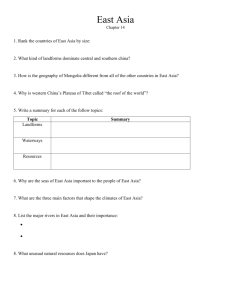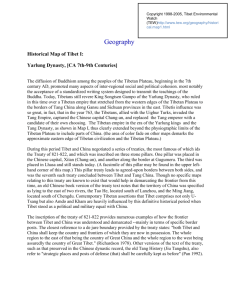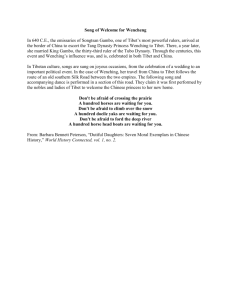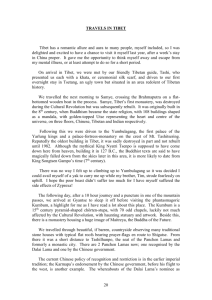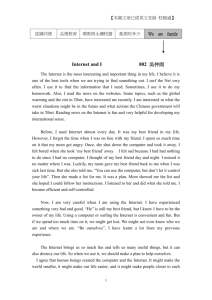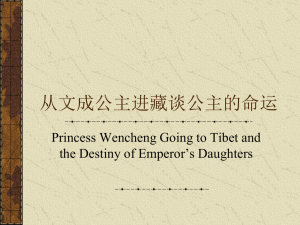Thermochronologic evidence for plateau formation in central Tibet by 45 Ma
advertisement
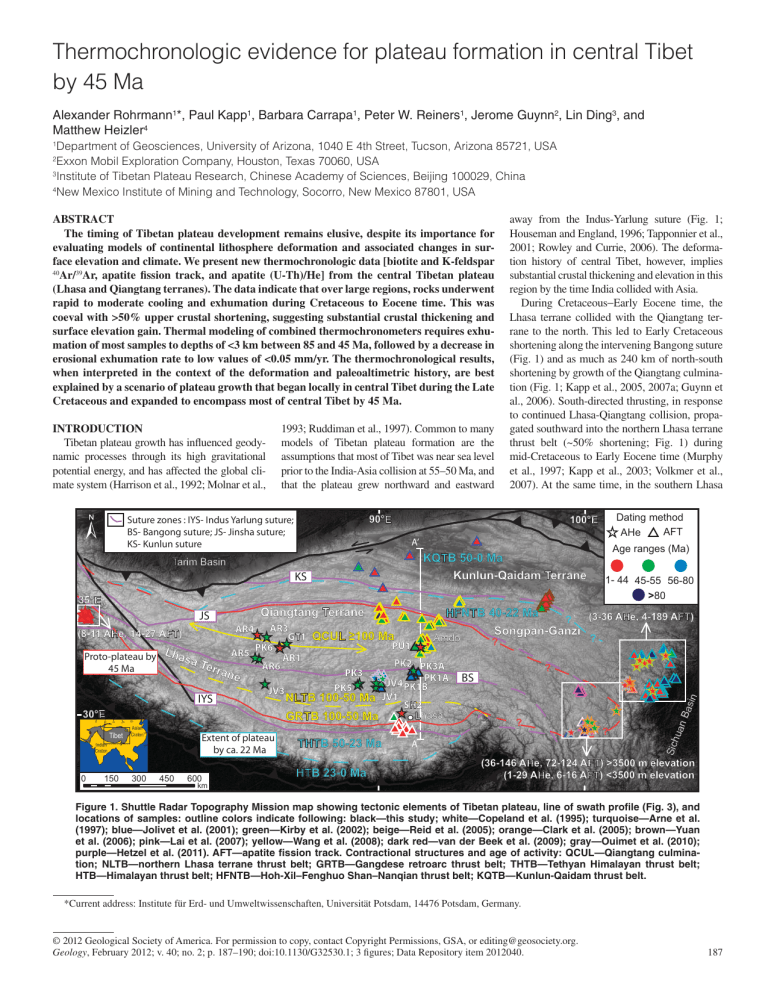
Thermochronologic evidence for plateau formation in central Tibet by 45 Ma Alexander Rohrmann1*, Paul Kapp1, Barbara Carrapa1, Peter W. Reiners1, Jerome Guynn2, Lin Ding3, and Matthew Heizler4 1 Department of Geosciences, University of Arizona, 1040 E 4th Street, Tucson, Arizona 85721, USA Exxon Mobil Exploration Company, Houston, Texas 70060, USA 3 Institute of Tibetan Plateau Research, Chinese Academy of Sciences, Beijing 100029, China 4 New Mexico Institute of Mining and Technology, Socorro, New Mexico 87801, USA 2 ABSTRACT The timing of Tibetan plateau development remains elusive, despite its importance for evaluating models of continental lithosphere deformation and associated changes in surface elevation and climate. We present new thermochronologic data [biotite and K-feldspar 40 Ar/39Ar, apatite fission track, and apatite (U-Th)/He] from the central Tibetan plateau (Lhasa and Qiangtang terranes). The data indicate that over large regions, rocks underwent rapid to moderate cooling and exhumation during Cretaceous to Eocene time. This was coeval with >50% upper crustal shortening, suggesting substantial crustal thickening and surface elevation gain. Thermal modeling of combined thermochronometers requires exhumation of most samples to depths of <3 km between 85 and 45 Ma, followed by a decrease in erosional exhumation rate to low values of <0.05 mm/yr. The thermochronological results, when interpreted in the context of the deformation and paleoaltimetric history, are best explained by a scenario of plateau growth that began locally in central Tibet during the Late Cretaceous and expanded to encompass most of central Tibet by 45 Ma. 1993; Ruddiman et al., 1997). Common to many models of Tibetan plateau formation are the assumptions that most of Tibet was near sea level prior to the India-Asia collision at 55–50 Ma, and that the plateau grew northward and eastward 90°E Suture zones : IYS- Indus Yarlung suture; BS- Bangong suture; JS- Jinsha suture; KS- Kunlun suture A’ Age ranges (Ma) KQTB 50-0 Ma Kunlun-Qaidam Terrane KS 1- 44 45-55 56-80 >80 35°E Qiangtang Terrane HFNTB 40-22 Ma 80 90 100 Tibet Indian Craton 0 150 110 Asian Craton 30 Extent of plateau by ca. 22 Ma 20 300 450 600 THTB 50-23 Ma HTB 23-0 Ma ? (3-36 AHe, 4-189 AFT) ? ? ? A ? Sic 70 ? Songpan-Ganzi asin AR3 AR4 (8-11 AHe, 14-27 AFT) GT1 QCUL ≥100 Ma Amdo PU1 PK6 L AR5 Proto-plateau by hasa AR1 PK2 PK3A Terr AR6 45 Ma ane PK3 PK1A BS JV4 PK1B PK5 JV3 NLTB 100-50 Ma JV1 IYS SH2 30°E Lhasa GRTB 100-50 Ma nB Tarim Basin JS Dating method AFT AHe 100°E hua INTRODUCTION Tibetan plateau growth has influenced geodynamic processes through its high gravitational potential energy, and has affected the global climate system (Harrison et al., 1992; Molnar et al., away from the Indus-Yarlung suture (Fig. 1; Houseman and England, 1996; Tapponnier et al., 2001; Rowley and Currie, 2006). The deformation history of central Tibet, however, implies substantial crustal thickening and elevation in this region by the time India collided with Asia. During Cretaceous−Early Eocene time, the Lhasa terrane collided with the Qiangtang terrane to the north. This led to Early Cretaceous shortening along the intervening Bangong suture (Fig. 1) and as much as 240 km of north-south shortening by growth of the Qiangtang culmination (Fig. 1; Kapp et al., 2005, 2007a; Guynn et al., 2006). South-directed thrusting, in response to continued Lhasa-Qiangtang collision, propagated southward into the northern Lhasa terrane thrust belt (~50% shortening; Fig. 1) during mid-Cretaceous to Early Eocene time (Murphy et al., 1997; Kapp et al., 2003; Volkmer et al., 2007). At the same time, in the southern Lhasa (36-146 AHe, 72-124 AFT) >3500 m elevation (1-29 AHe, 6-16 AFT) <3500 m elevation km Figure 1. Shuttle Radar Topography Mission map showing tectonic elements of Tibetan plateau, line of swath profile (Fig. 3), and locations of samples: outline colors indicate following: black—this study; white—Copeland et al. (1995); turquoise—Arne et al. (1997); blue—Jolivet et al. (2001); green—Kirby et al. (2002); beige—Reid et al. (2005); orange—Clark et al. (2005); brown—Yuan et al. (2006); pink—Lai et al. (2007); yellow—Wang et al. (2008); dark red—van der Beek et al. (2009); gray—Ouimet et al. (2010); purple—Hetzel et al. (2011). AFT—apatite fission track. Contractional structures and age of activity: QCUL—Qiangtang culmination; NLTB—northern Lhasa terrane thrust belt; GRTB—Gangdese retroarc thrust belt; THTB—Tethyan Himalayan thrust belt; HTB—Himalayan thrust belt; HFNTB—Hoh-Xil–Fenghuo Shan–Nanqian thrust belt; KQTB—Kunlun-Qaidam thrust belt. *Current address: Institute für Erd- und Umweltwissenschaften, Universität Potsdam, 14476 Potsdam, Germany. © 2012 Geological Society of America. For permission to copy, contact Copyright Permissions, GSA, or editing@geosociety.org. GEOLOGY, February 2012 Geology, February 2012; v. 40; no. 2; p. 187–190; doi:10.1130/G32530.1; 3 figures; Data Repository item 2012040. 187 1 GSA Data Repository item 2012040, details of geochronologic and thermochronologic analysis and samples (Figures DR1−DR4; Tables DR1−DR5 and DR7), and description of thermal modeling (Figure DR5; Table DR6), is available online at www.geosociety .org/pubs/ft2012.htm, or on request from editing@ geosociety.org or Documents Secretary, GSA, P.O. Box 9140, Boulder, CO 80301, USA. 188 150 RESULTS Samples of a Cretaceous granite in the Lhasa terrane (JV4) and one in the central Qiangtang terrane (PU1) yielded 40Ar/39Ar biotite ages of 120 ± 0.3 Ma and 68.9 ± 0.1 Ma, respectively (Figs. DR2 and DR3; Table DR4). The Qiangtang granite (PU1) furthermore yielded a K-feldspar total gas age of 68.6 ± 0.2 Ma, similar to its U-Pb zircon crystallization age of 69.2 ± 1.2 Ma (Fig. DR1; Table DR3), consistent with granite emplacement at shallow levels and rapid conductive cooling. K-feldspar multidomain diffusion modeling of JV4 yielded a thermal history that shows rapid exhumation from the mid-crust beginning ca. 100 Ma (Fig. 2A). Previously published 40Ar/39Ar K-feldspar studies on samples of Amdo orthogneiss (PK1A, PK2, PK3A; Guynn et al., 2006), for which we here present new AHe and AFT data, and other granites along the Bangong suture in Tibet (Kapp et al., 2003, 2007a) similarly show episodes of rapid cooling from mid-crustal levels to <150 °C during the Cretaceous. The 7 AFT ages for central Tibetan samples range from 75 to 53 Ma (Fig. 1; Fig. DR4; Table DR5) and the 15 AHe ages range from 55 to 15 Ma (Fig. 1; Table DR7), the majority (11 of 15) being 49 ± 6 Ma. Of the four youngest ages (37 Ma, 28 Ma, 19 Ma, 15 Ma), three are from Qiangtang terrane samples located in the hanging walls of small-displacement thrust faults that cut mid-Cenozoic strata (Kapp et al., 2005). The youngest age (15 Ma) is from a sample collected within an externally draining river valley near Lhasa in the southern Lhasa terrane (SH2, Fig. 1). Overall, most AFT and AHe ages are Cretaceous–early Cenozoic, indicating minimal exhumation since ca. 45 Ma. Only samples PU1, PK3, and JV1 provided acceptable results when AFT and AHe data were used together for the thermal-kinetic modeling; other samples were modeled using either AFT or AHe data (Table DR6). The 10 samples modeled all show a transition from relatively rapid to very slow cooling between 85 and 43 Ma (red dots in Fig. 2B). The narrow range of most AHe ages, ca. 50 Ma, over large distances in central Tibet (Fig. 2C), however, is consistent with widespread, relatively rapid cooling through the AHe partial retention zone 40 T (°C) data, was conducted using the HeFTy program (Ketcham, 2005). Kinetic effects (apatite chemistry for AFT; radiation damage for AHe) are accounted for in the modeling (Table DR6 in the Data Repository). 40Ar/39Ar thermochronology of biotite and K-feldspar and multidomain diffusion modeling of K-feldspars constrain cooling through the ~350–100 °C window, and when combined with AFT and AHe can resolve indirectly the exhumation history of the mid-upper crust. A PK2 PK1A PU1 PK3 JV4 250 350 0 160 120 80 120 Time (Ma) 80 B AR 5 40 40 0 0 AR 3 AR 6 1 JV 3 2 PRZ AHe+AFT 3 PK 5 T (°C) 80 4 120 PK 2 5 PK 1B Depth (km) GT 1 160 PU 1 JV 1 200 5 Frequency terrane, the Gangdese retroarc thrust belt (Fig. 1) shortened >50% during northward subduction of Neotethyan oceanic lithosphere (Kapp et al., 2007b). How shortening was accommodated in the lower crust is unknown. Nevertheless, it is reasonable to conclude that 50% shortening over such a large region (modern north-south width of ~500 km) led to substantial crustal thickening and elevation gain in central Tibet. This deformation history, together with widespread exposures of nearly flat-lying Paleogene volcanic rocks, led to the proposition that plateau-like conditions were established in parts of these terranes by 50 Ma (Murphy et al., 1997; Kapp et al., 2007a, 2007b). Except along active rifts (e.g., Harrison et al., 1992) and deeply incised river valleys (Clark et al., 2005; Ouimet et al., 2010), the modern plateau is distinguished from its high-relief margins by low erosion rates (<0.04 mm/yr; Lal et al., 2004; Hetzel et al., 2011). Thermochronologic studies in parts of the northwestern Himalaya and western Tibet indicate steady, slow erosion since at least 35 Ma, and were interpreted to indicate the establishment of a plateau by that time (van der Beek et al., 2009). When low erosion rates were established in the plateau interior is not well known, but can be addressed by application of low-temperature thermochronology. Apatite fission track (AFT) and apatite (U-Th)/He (AHe) ages can be interpreted to record the time elapsed since cooling of rock through a temperature window called the partial retention zone (AFT ~60–120 °C; AHe ~50–80 °C), constraining the timing and rate of cooling and indirectly exhumation. Rock samples collected in the Qiangtang and Lhasa terranes (Fig. 1) were analyzed using biotite and K-feldspar 40Ar/39Ar, AFT, and AHe dating (for details on methods, see the GSA Data Repository1). The samples were collected >25 km from active rifts over a large (~32 × 104 km2) well-mapped area to resolve the regional temporal-spatial distribution of exhumation. The 19 new samples analyzed in total (yielding 15 AHe ages, 7 AFT ages, and 5 40 Ar/39Ar ages) include 9 Mesozoic granites and 1 metasedimentary rock in the Qiangtang terrane, 5 Cretaceous granites in the northern Lhasa terrane, 3 Cambrian–Ordovician orthogneisses within the Bangong suture near Amdo (Fig. 1), and 1 Eocene granite near Lhasa (Fig. 1). Inverse thermal-kinetic modeling of AFT ages and track length data, together with AHe 2 C 6 AFT AHe 120 80 Age (Ma) 40 0 Figure 2. Cooling histories. A: Multidomain diffusion K-spar modeling results. B: HeFTy program modeling results showing best fits for each sample. Red dots indicate inflections points showing decreases in cooling rate. Converted depth scale using paleogeothermal gradient of 25 °C/km. PRZ—partial retention zone; AFT—apatite fission track; AHe—apatite (U-Th)/He. C: Histogram of AFT and AHe ages (this study). at the time (Fig. 2B). Assuming a paleogeothermal gradient of 25 °C/km yields average erosional exhumation rates of 0.05–0.01 mm/ yr for modeled samples since their transition to slow cooling (Fig. 2B). A subset of the samples shows a later episode of cooling (Fig. 2B), including three AHe ages, that may be attributed to localized thrust reactivation. DISCUSSION AND CONCLUSION The new data presented here, combined with a low-temperature thermochronologic study of an igneous complex in the Lhasa terrane (Hetzel et al., 2011; same region as JV1 and JV4 samples; Fig. 1), suggest that in most places in central Tibet, erosion rates of <0.05 mm/yr were established by ca. 45 Ma. These low rates are consistent with widespread exposures of flat-lying 45–38 Ma volcanic rocks above an angular unconformity in the northern Qiangtang terrane (Wang et al., 2008), requiring that the underlying rocks were shortened and at the surface before volcanism. The more rapid Late Cretaceous to Eocene cooling in central Tibet was attributed by Hetzel et al. (2011) to the GEOLOGY, February 2012 GEOLOGY, February 2012 Elevation (km) JS BNS IYS 7 KS 6 5 4 3 Maximum elevation 2 0 80 1- 44 Cenozoic exhumation insufficient to reset ages 2. 60 40 Age range (Ma) Mean elevation Minimum elevation 1 Age (M a) formation of a low-elevation erosional planation surface during a period of tectonic quiescence by southward-draining rivers. The interpretation, however, is inconsistent with ≥50% upper crustal shortening in the Lhasa terrane between 100 and 52 Ma, coeval Gangdese arc magmatism, and Paleocene–Eocene internally drained, syncontractional basins in central Tibet (Horton et al., 2002). Furthermore, the observation that some planation surfaces cut rocks as young as Miocene (Shackleton and Chengfa, 1988), after uplift to near-modern elevations by Eocene–Oligocene time based on paleoaltimetry (Rowley and Currie, 2006; DeCelles et al., 2007; Quade et al., 2011), suggests that planation surfaces can form at high elevation. Although several factors influence erosion rates, we interpret the initiation of slow erosion in central Tibet as a proxy for establishment of regional low relief at high elevation. Samples showing a transition to slow cooling before 55 Ma (Fig. 2B) suggest that pre–India-Asia collision tectonism may have led to localized regions of protoplateau development. The early impact of the India-Asia collision, however, appears to have caused major plateau expansion based on the narrow range of most AHe ages at 49 ± 6 Ma (Fig. 2C). A possible mechanism is underthrusting of greater Indian lithosphere as far north as the northern Qiangtang terrane by 45 Ma, when volcanism initiated in this region, and during a time interval when India-Asia convergence rates were >90 mm/yr (van Hinsbergen et al., 2011). Between 32 and 20 Ma, volcanism swept back as far south as the Indus-Yarlung suture, maybe in response to rollback of greater Indian lithosphere (DeCelles et al., 2011). A compilation of our data with published low-temperature thermochronologic ages from other parts of Tibet reveals a northward trend to younger ages (Fig. 3; Table DR2). AFT ages in the northern Qiangtang and Songpan-Ganzi terranes are mainly Eocene to Oligocene and overlap in time and space with the northwardyounging Paleocene to Early Miocene HohXil–Fenghuo Shan–Nanqian thrust belt (Spurlin et al., 2005; Wang et al., 2008; Fig. 1). A southward younging of ages from central Tibet is also apparent (Fig. 3), but the younger ages in the southern Lhasa terrane are interpreted to record mid-Cenozoic exhumation in the hanging wall of the out-of-sequence Gangdese thrust system (Yin et al., 1999; Harrison et al., 2000) rather than when substantial elevation was obtained. The Tethyan Himalayan thrust belt (Fig. 1) initiated during the Early Eocene (Ratschbacher et al., 1994; Aikman et al., 2008). Major upper crustal shortening ceased by ca. 40 Ma in the northern Qiangtang terrane, ca. 22 Ma in the Songpan-Ganzi terrane (Wang et al., 2008), and ca. 23 Ma in the Tethyan Himalayan thrust belt when the Main Central thrust zone initiated 56-80 This study Copeland et al., 1995 Jolivet et al., 2001 Yuan et al., 2006 Wang et al., 2008 Hetzel et al., 2011 1. Localized thrust reactivation 20 0 A 45-55 30 32 Latitude (°N) 34 36 A′ Figure 3. Top: 1400-km-wide topographic swath profile along 92°E (Fig. 1) onto which lowtemperature thermochronologic ages from 84°E to 98°E are projected. Purple dashed lines indicate locations of sutures: IYS—Indus-Yarlung; BNS—Bangong; JS—Jinsha; KS—Kunlun. Symbols as in Figure 1. Bottom: Low-temperature thermochronologic ages projected into profile. 1—Fields indicating timing of Gangdese thrust system and river incision in region. 2—Fields indicating northward younging trend in ages. (Hodges et al., 1996). Collectively, the history of deformation and exhumation is well explained by the establishment of a plateau in the Qiangtang and Lhasa terranes by Eocene time, and its subsequent northward and southward growth during the India-Asia collision (e.g., Kapp et al., 2007a; Wang et al., 2008). Studies in eastern Tibet identified low-relief landscapes that are deeply incised (Clark et al., 2005, 2006; Ouimet et al., 2010). In this area, rocks at high elevation (>3500 m) yield Mesozoic to early Cenozoic AFT and AHe ages, similar to those in central Tibet, and those at lower elevations within gorges (<3000 m) yield mainly Neogene ages (Fig. 1). Modeling of these data suggests initiation of river incision at 15–9 Ma, interpreted as a response to rapid uplift of low-relief landscapes as the crust was thickened by channel flow of mid-crust from beneath central Tibet (Clark et al., 2005). Near Lhasa, within a deeply incised river valley, we obtained an AHe age of 15 Ma, consistent with AHe ages from intermediate elevations in eastern Tibet. Near Lhasa, however, the rivers are incising into an interior part of the plateau that obtained high elevation by no later than 15 Ma (Spicer et al., 2003), and probably by Eocene time (Rowley and Currie, 2006; Kapp et al., 2007b). The Yellow River has incised and eroded headward into extensive Miocene lacustrine strata deposited in closed basins (Wu et al., 2008) and other vast, formerly internally drained regions of the northeastern plateau since 1.8 Ma (Craddock et al., 2010). On the basis of these observations, we propose the possibility that at least some of the low- relief landscapes in eastern Tibet were part of a high plateau significantly prior to Miocene river incision. In conclusion, the history of exhumation, deformation, and basin development in Tibet supports the proposition that plateau-like conditions began developing in central Tibet during the Late Cretaceous and were regionally extensive by 45 Ma. Future studies are needed to test the possibility of northward underthrusting of greater Indian lithosphere beneath central Tibet by 45 Ma and to better resolve the eastward plateau growth history between central Tibet and the Longmen Shan, which has undergone major surface uplift since Middle Miocene time (e.g., Kirby et al., 2002). ACKNOWLEDGMENTS The research was supported by grants from the National Science Foundation (EAR-0438120, EAR0808976 and EAR-1008527), donors to the American Chemical Society Petroleum Research Fund, and the Chinese Academy of Sciences (grant KZCX2-YWQ09-03 to Ding). REFERENCES CITED Aikman, A.B., Harrison, T.M., and Ding, L., 2008, Evidence for early (>44 Ma) Himalayan crustal thickening, Tethyan Himalaya, southeastern Tibet: Earth and Planetary Science Letters, v. 274, p. 14–23, doi:10.1016/j.epsl.2008.06.038. Arne, D., Worley, B., Wilson, C., Chen, S., Foster, D., Luo, Z., Liu, S., and Dirks, P., 1997, Differential exhumation in response to episodic thrusting along the eastern margin of the Tibetan Plateau: Tectonophysics, v. 280, p. 239– 256, doi:10.1016/S0040-1951(97)00040-1. Clark, M.K., House, M.A., Royden, L.H., Whipple, K.X., Burchfiel, B.C., Zhang, X., and Tang, W., 2005, Late Cenozoic uplift of southeastern 189 Tibet: Geology, v. 33, p. 525–528, doi:10.1130/ G21265.1. Clark, M.K., Royden, L.H., Whipple, K.X., Burchfiel, B.C., Zhang, X., and Tang, W., 2006, Use of a regional, relict landscape to measure vertical deformation of the eastern Tibetan Plateau: Journal of Geophysical Research, v. 111, F03002, doi:10.1029/2005JF000294. Copeland, P., Harrison, T.M., Pan, Y., Kidd, W.S.F., Roden, M., and Zhang, Y., 1995, Thermal evolution of the Gangdese batholith, southern Tibet: A history of episodic unroofing: Tectonics, v. 14, p. 223–226, doi:10.1029/94TC01676. Craddock, W.H., Kirby, E., Harkins, N.W., Zhang, H., Shi, X., and Liu, J., 2010, Rapid fluvial incision along the Yellow River during headward basin integration: Nature Geoscience, v. 3, p. 209–213, doi:10.1038/ngeo777. DeCelles, P.G., Quade, J., Kapp, P., Fan, M., Dettman, D.L., and Ding, L., 2007, High and dry in central Tibet during the Late Oligocene: Earth and Planetary Science Letters, v. 253, p. 389– 401, doi:10.1016/j.epsl.2006.11.001. DeCelles, P.G., Kapp, P., Quade, J., and Gehrels, G.E., 2011, Oligocene–Miocene Kailas basin, southwestern Tibet: Record of postcollisional upper plate extension in the Indus-Yarlung suture zone: Geological Society of America Bulletin, v. 123, p. 1337–1362, doi:10.1130/B30258.1. Guynn, J.H., Kapp, P., Pullen, A., Heizler, M., Gehrels, G., and Ding, L., 2006, Tibetan basement rocks near Amdo reveal “missing” Mesozoic tectonism along the Bangong suture, central Tibet: Geology, v. 34, p. 505–508, doi:10.1130/G22453.1. Harrison, T.M., Copeland, P., Kidd, W.S.F., and Yin, A., 1992, Raising Tibet: Science, v. 255, p. 1663– 1670, doi:10.1126/science.255.5052.1663. Harrison, T.M., Yin, A., Grove, M., Lovera, O.M., Ryerson, F.J., and Zhou, X., 2000, The Zedong Window: A record of superposed Tertiary convergence in southeastern Tibet: Journal of Geophysical Research, v. 105, p. 19211–19230, doi:10.1029/2000JB900078. Hetzel, R., Dunkl, I., Haider, V., Strobl, M., von Eynatten, H., Ding, L., and Frei, D., 2011, Peneplain formation in southern Tibet predates the India-Asia collision and plateau uplift: Geology, v. 39, p. 983–986, doi:10.1130/G32069.1. Hodges, K.V., Parrish, R.R., and Searle, M.P., 1996, Tectonic evolution of the central Annapurna Range, Nepalese Himalayas: Tectonics, v. 15, p. 1264–1291, doi:10.1029/96TC01791. Horton, B.K., Yin, A., Spurlin, M.S., Zhou, J., and Wang, J., 2002, Paleocene–Eocene syncontractional sedimentation in narrow, lacustrinedominated basins of east-central Tibet: Geological Society of America Bulletin, v. 114, p. 771–786, doi:10.1130/0016-7606(2002)114 <0771:PESSIN>2.0.CO;2. Houseman, G., and England, P., 1996, A lithosphericthickening model for the Indo-Asian collision, in Yin, A., and Harrison, T.M., eds., The tectonic evolution of Asia: New York, Cambridge University Press, p. 3–17. Jolivet, M., Brunel, M., Seward, D., Xu, Z., Yang, J., Roger, F., Tapponnier, P., Malavieille, J., Arnaud, N., and Wu, C., 2001, Mesozoic and Cenozoic tectonics of the northern edge of the Tibetan plateau: Fission-track constraints: Tectonophysics, v. 343, p. 111–134, doi:10.1016/ S0040-1951(01)00196-2. Kapp, P., Murphy, M.A., Yin, A., Harrison, T.M., Ding, L., and Guo, J., 2003, Mesozoic and Cenozoic tectonic evolution of the Shiquanhe area of western Tibet: Tectonics, v. 22, 1029, doi:10.1029/2001TC001332. 190 Kapp, P., Yin, A., Harrison, T.M., and Ding, L., 2005, Cretaceous–Tertiary shortening, basin development, and volcanism in central Tibet: Geological Society of America Bulletin, v. 117, p. 865– 878, doi:10.1130/B25595.1. Kapp, P., DeCelles, P.G., Gehrels, G.E., Heizler, M., and Ding, L., 2007a, Geological records of the Cretaceous Lhasa-Qiangtang and Indo-Asian collisions in the Nima basin area, central Tibet: Geological Society of America Bulletin, v. 119, p. 917–933, doi:10.1130/B26033.1. Kapp, P., DeCelles, P.G., Leier, A.L., Fabijanic, J.M., He, S., Pullen, A., Gehrels, G.E., and Ding, L., 2007b, The Gangdese retroarc thrust belt revealed: GSA Today, v. 17, p. 4–9, doi:10.1130/ GSAT01707A.1. Ketcham, R.A., 2005, Forward and inverse modeling of low-temperature thermochronometry data: Mineralogical Society of America Reviews in Mineralogy and Geochemistry, v. 58, p. 275– 314, doi:10.2138/rmg.2005.58.11. Kirby, E., Reiners, P.W., Krol, M.A., Whipple, K.X., Hodges, K.V., Farley, K.A., Tang, W., and Chen, Z., 2002, Late Cenozoic evolution of the eastern margin of the Tibetan Plateau: Inferences from 40Ar/ 39Ar and (U-Th)/He thermochronology: Tectonics, v. 21, p. 1–20, doi:10.1029/2000TC001246. Lai, Q., Ding, L., Wang, H., Yue, Y., and Cai, F., 2007, Constraining the stepwise migration of the eastern Tibetan Plateau margin by apatite fission track thermochronology: Sciences in China Series D: Earth Sciences, v. 50, p. 172– 183, doi:10.1007/s11430-007-2048-7. Lal, D., Harris, N.B.W., Sharma, K.K., Gu, Z., Ding, L., Liu, T., Dong, W., Caffee, M.W., and Jull, A.J.T., 2004, Erosion history of the Tibetan Plateau since the last interglacial: Constraints from the first studies of cosmogenic 10Be from Tibetan bedrock: Earth and Planetary Science Letters, v. 217, p. 33–42, doi:10.1016/S0012821X(03)00600-9. Molnar, P., England, P., and Martinod, J., 1993, Mantle dynamics, uplift of the Tibetan Plateau, and the India monsoon: Reviews of Geophysics, v. 31, p. 357–396, doi:10.1029/93RG02030. Murphy, M.A., Yin, A., Harrison, T.M., Dürr, S.B., Chen, Z., Ryerson, F.J., Kidd, W.S.F., Wang, X., and Zhou, X., 1997, Did the Indo-Asian collision alone create the Tibetan plateau?: Geology, v. 25, p. 719–722, doi:10.1130/0091-7613 (1997)025<0719:DTIACA>2.3.CO;2. Ouimet, W., Whipple, K., Royden, L., Reiners, P.W., Hodges, K., and Pringle, M., 2010, Regional incision of the eastern margin of the Tibetan Plateau: Lithosphere, v. 2, p. 50–63, doi:10.1130/L57.1. Quade, J., Breecker, D., Daeron, M., and Eiler, J., 2011, The paleoaltimetry of Tibet: An isotopic perspective: American Journal of Science, v. 311, p. 77–115, doi:10.2475/02.2011.01. Ratschbacher, L., Frisch, W., Liu, G., and Chen, C., 1994, Distributed deformation in southern and western Tibet during and after the India-Asia collision: Journal of Geophysical Research, v. 99, p. 917–945, doi:10.1029/94JB00932. Reid, A., Fowler, A., Phillips, D., and Wilson, C., 2005, Thermochronology of the Yidun Arc, central eastern Tibetan Plateau: Constraints from Ar/Ar K-feldspar and apatite fission track data: Journal of Asian Earth Sciences, v. 25, p. 915–935, doi:10.1016/j.jseaes.2004.09.002. Rowley, D.B., and Currie, B.S., 2006, Palaeo-altimetry of the late Eocene to Miocene Lunpola basin, central Tibet: Nature, v. 439, p. 677–681, doi:10.1038/nature04506. Ruddiman, W.F., Raymo, M.E., Prell, W.L., and Kutzbach, J.E., 1997, The uplift-climate connection: A synthesis, in Ruddiman, W.F., ed., Tectonic uplift and climate change: New York, Plenum Press, p. 471–515. Shackleton, R.M., and Chengfa, C., 1988, Cenozoic uplift and deformation of the Tibetan Plateau: The geomorphological evidence: Royal Society of London Philosophical Transactions, ser. A, v. 327, p. 365–377, doi:10.1098/ rsta.1988.0134. Spicer, R.A., Harris, N.B.W., Widdowson, M., Herman, A.B., Guo, S., Valdes, P.J., Wolfe, J.A., and Kelley, S.P., 2003, Constant elevation of southern Tibet over the past 15 million years: Nature, v. 421, p. 622–624, doi:10.1038/ nature01356. Spurlin, M.S., Yin, A., Horton, B.K., Zhou, J., and Wang, J., 2005, Structural evolution of the Yushu-Nangqian region and its relationship to syncollisional igneous activity, east-central Tibet: Geological Society of America Bulletin, v. 117, p. 1293–1317, doi:10.1130/B25572.1. Tapponnier, P., Xu, Z., Roger, F., Meyer, B., Arnaud, N., Wittlinger, G., and Yang, J., 2001, Oblique stepwise rise and growth of the Tibet Plateau: Science, v. 294, p. 1671–1677, doi:10.1126/ science.105978. van der Beek, P., Van Melle, J., Guillot, S., Pêcher, A., Reiners, P.W., Nicolescu, S., and Latif, M., 2009, Eocene Tibetan plateau remnants preserved in the northwest Himalaya: Nature Geoscience, v. 2, p. 364–368, doi:10.1038/ngeo503. van Hinsbergen, D.J.J., Steinbergen, B., Doubrovine, P.V., and Gassmoller, R., 2011, Acceleration and deceleration of India-Asia convergence since the Cretaceous: Roles of mantle plumes and continental collision: Journal of Geophysical Research, v. 116, B06101, doi:10.1029/2010JB008051. Volkmer, J.E., Kapp, P., Guynn, J.H., and Lai, Q., 2007, Cretaceous–Tertiary structural evolution of the north central Lhasa terrane, Tibet: Tectonics, v. 26, TC6007, doi:10.1029/2005TC001832. Wang, C., Zhao, X., Liu, Z., Lippert, P.C., Graham, S.A., Coe, R.S., Yi, H., Zhu, L., Liu, S., and Li, Y., 2008, Constraints on the early uplift history of the Tibetan Plateau: National Academy of Sciences Proceedings, v. 105, p. 4987–4992, doi:10.1073/pnas.0703595105. Wu, Z., Barosh, P.J., Wu, Z., Hu, D., Zhao, X., and Ye, P., 2008, Vast early Miocene lakes of the central Tibetan Plateau: Geological Society of America Bulletin, v. 120, p. 1326–1337, doi:10.1130/B26043.1. Yin, A., Harrison, T.M., Murphy, M.A., Grove, M., Nie, S., Ryerson, F.J., Wang, X.F., and Chen, Z.L., 1999, Tertiary deformation history of southeastern and southwestern Tibet during the IndoAsian collision: Geological Society of America Bulletin, v. 111, p. 1644–1664, doi:10.1130/0016 -7606(1999)111<1644:TDHOSA>2.3.CO;2. Yuan, W., Dong, J., Shicheng, W., and Carter, A., 2006, Apatite fission track evidence for Neogene uplift in the eastern Kunlun Mountains, northern Qinghai–Tibet Plateau, China: Journal of Asian Earth Sciences, v. 27, p. 847–856, doi:10.1016/j.jseaes.2005.09.002. Manuscript received 6 June 2011 Revised manuscript received 26 September 2011 Manuscript accepted 19 October 2011 Printed in USA GEOLOGY, February 2012
